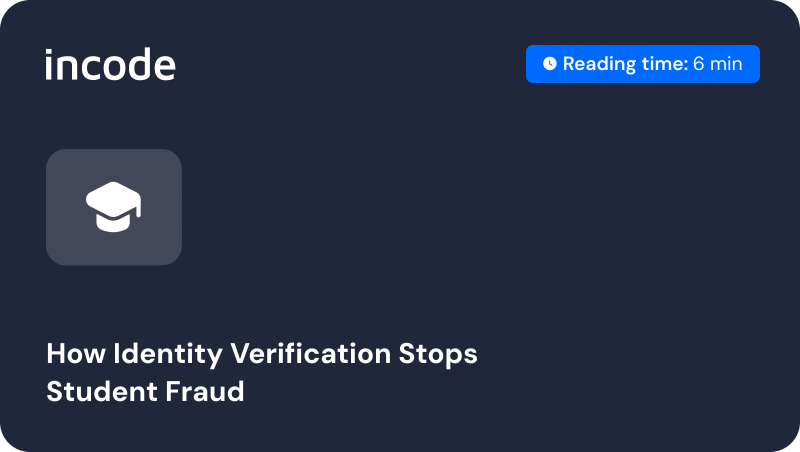The Free Application for Federal Student Aid (FAFSA) was created to help students afford college. But in 2025, sophisticated fraud rings are exploiting it to steal millions.
Across the U.S. a rising tide of FAFSA fraud is targeting community colleges, online programs, and underfunded institutions. In some schools, up to one-third of applicants are flagged as suspicious. With identity-based scams growing more sophisticated, even seasoned fraud teams are struggling to keep up.
Now, the U.S. Department of Education is taking action. In June, U.S. Secretary of Education Linda McMahon issued a clear warning:
“When rampant fraud is taking aid away from eligible students, disrupting the operations of colleges, and ripping off taxpayers, we have a responsibility to act.”
With that statement, a new wave of scrutiny, verification tools, and vendor evaluations has begun.
How FAFSA Fraud Works in 2025
Today’s FAFSA scams are industrialized, AI-enhanced, and deeply automated. These are sophisticated operations involving forged diplomas and paperwork errors. Here’s the basic playbook:
- Stolen identities from breached databases or the dark web are used to impersonate real people including minors, the elderly, or incarcerated individuals.
- Automated botnets submit hundreds of fake FAFSA applications, using VPNs and disposable emails to avoid detection.
- Online community colleges and other underfunded institutions are targeted due to low tuition and minimal verification.
- Financial aid refunds are directed to third-party accounts controlled by fraudsters.
- Ghost students vanish once the disbursement hits, never attending class or repaying loans.
A Fortune article revealed that, according to a Department of Education advisory, about $90 million in aid was doled out to ineligible students, with some $30 million traced to dead people whose identities were used to enroll in classes.

Real Cases, Real Damage
- In California, community colleges saw over $10 million in federal aid and $3 million in state funds stolen by fraudulent applicants in a single year.
- One Louisiana case involved a man who was convicted for using personal information of 180 individuals to fraudulently obtain over $1.4 million in financial aid at Baton Rouge Community College from 2017 to 2019.
- In Nevada, the College of Southern Nevada wrote off $7.4 million in the Fall 2024 semester because of fraudulent enrollments.
- Recently, entire online classes have been filled with AI-generated students or ghost-students, with chatbots turning in AI-written homework just long enough to qualify for a payout.

What Can Be Done Now
Stopping FAFSA fraud starts with rethinking how we verify identity, detect anomalies, and disburse funds. Here’s what actually works:
1. Strengthen Identity Verification
- Biometric document + selfie match for all first-time applicants.
- Liveness detection to ensure the user is physically present and real.
- Cross-check identity with official identity documents to flag synthetic identities.
2. Analyze Behavior and Risk Patterns
- Flag multiple applications from the same IP, device, or phone.
- Detect bot-like behavior using AI-powered fraud signals.
3. Lock Down Refund Accounts
- Require ownership verification for bank accounts before payout.
- Use multi-factor authentication for refund changes.
- Delay disbursement until class attendance or live onboarding.
4. Raise Enrollment Standards
- Verify diplomas and transcripts through national clearinghouses.
- Require ID validation for online-only students.
- Alert instructors to ghost behavior or suspiciously identical submissions.
The Future of Student Aid Depends on Trust
In response to the surge in fraud, the Department of Education is already rolling out enhanced identity verification requirements for 125,000 FAFSA applicants. This represents an unprecedented step for federal aid verification requiring students to present government-issued photo ID either in person or via live video conference.
Technology alone won’t solve this. We need partnerships between agencies, schools, and trusted identity providers to build an ecosystem where fraud can’t thrive.
How Incode Helps Stop FAFSA Fraud
At Incode, we work with education organizations to:
- Stop bots, deepfakes, and fake IDs before they can submit an application.
- Verify user identity and behavior in real time, with minimal friction.
- Protect disbursement channels by validating account ownership and usage.
- Balance speed and security, ensuring eligible students get aid quickly.
We’ve already helped institutions from diverse sectors around the world modernize how they detect and prevent fraud. Now, we’re ready to help higher education do the same.
Our Technology Advantage
- Passive Liveness Detection: Verify real users in 40 milliseconds with no user interaction required.
- Advanced Document Verification: Analyze 4,900+ document types with 25% better OCR accuracy than competitors.
- AI-Powered Fraud Lab: Proprietary models trained on millions of verification sessions to detect emerging fraud patterns.
- Enterprise-Grade Security: Built for scale with uptime guarantees and enterprise compliance.

Let’s Bring Integrity Back to Student Aid
Every fraudulent FAFSA form represents a student displaced, a taxpayer deceived, and a system under siege.
This is fixable. The tools already exist.
Ready to secure your institution against FAFSA fraud? Talk to our team today to see how Incode can help your institution or agency detect, prevent, and eliminate FAFSA fraud with speed, accuracy, and trust.


